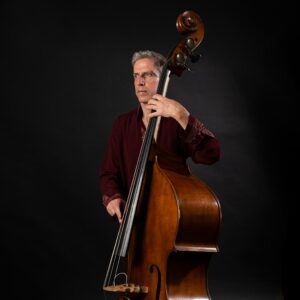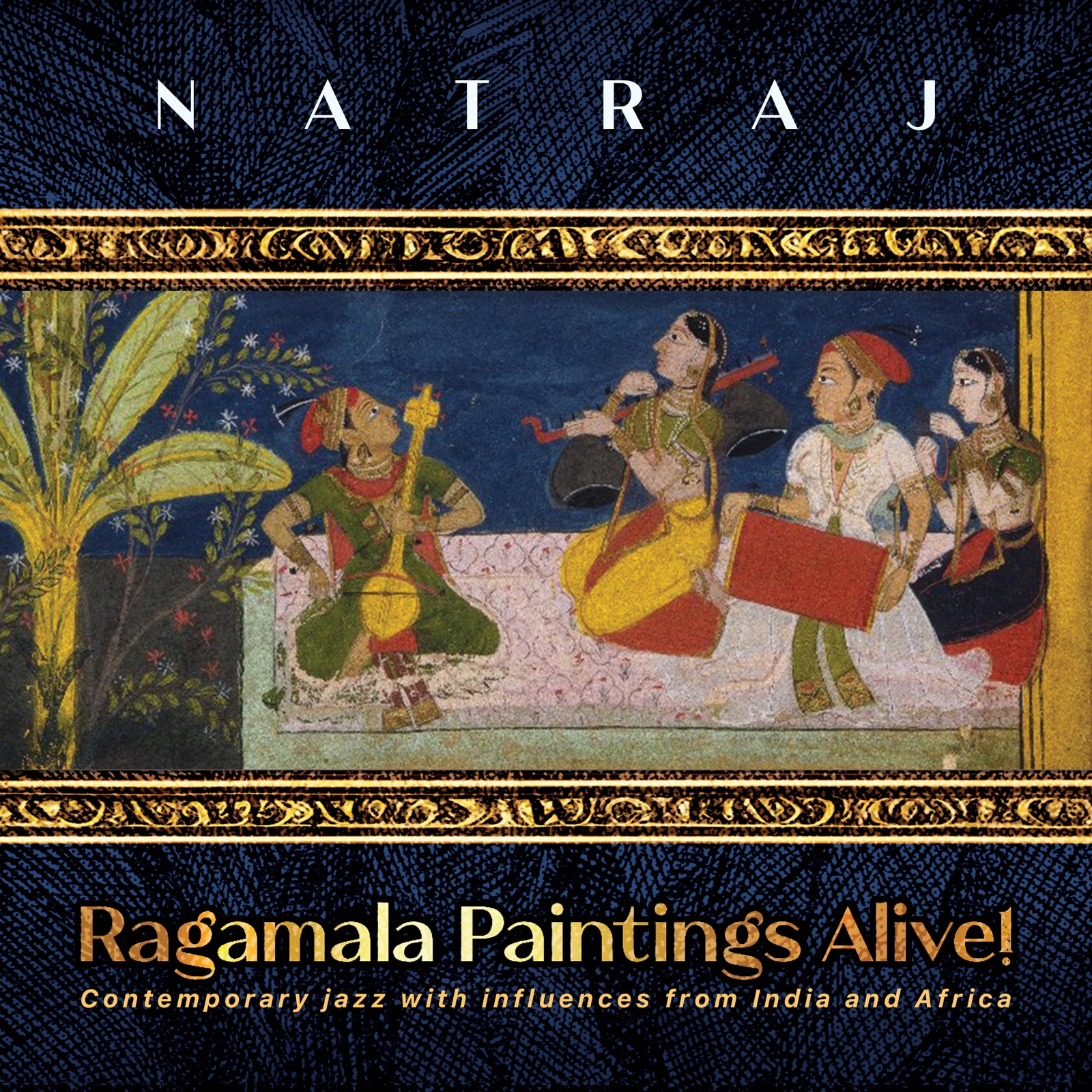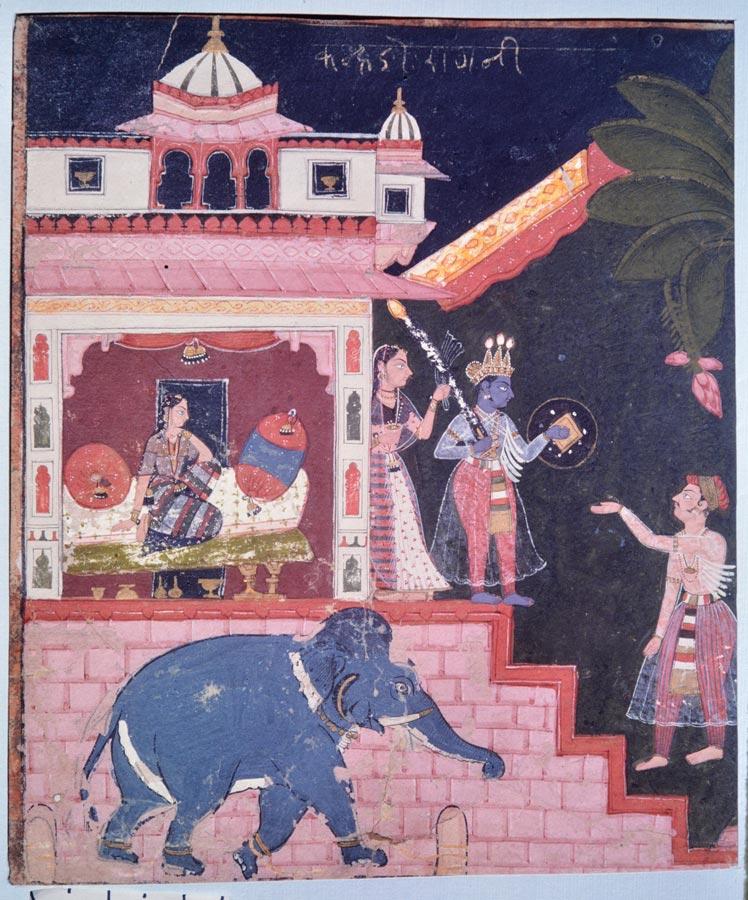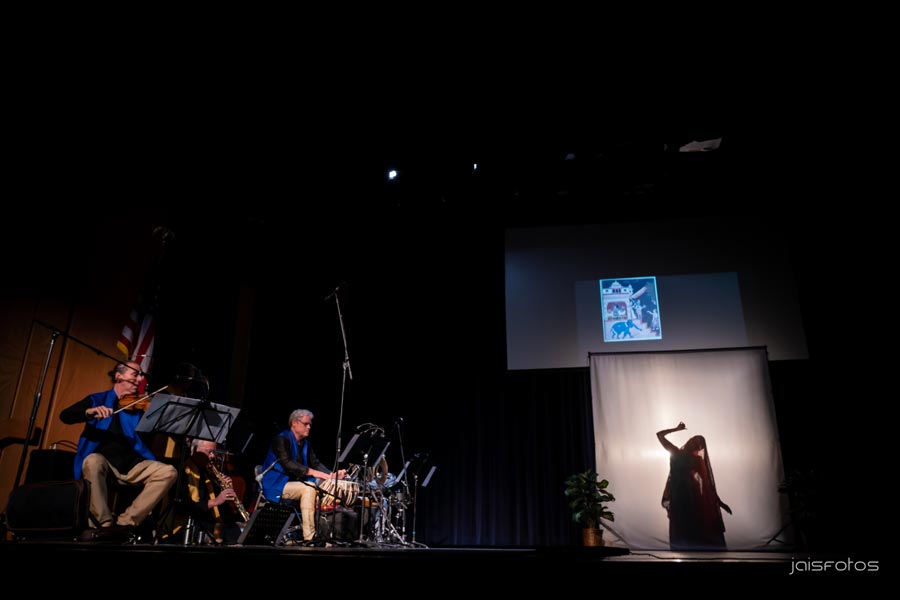Ragamala Paintings Alive!
Natraj
Phil Scarff soprano saxophone, electronic tamboura
Rohan Gregory violin
Mike Rivard bass
Jerry Leake tabla, gung-gong, frame drum, bells
Bertram Lehmann drum set
Special guest: Jayshree Bala Rajamani voice
Composed by Phil Scarff and performed by world-jazz ensemble Natraj, RAGAMALA PAINTINGS ALIVE! shines a contemporary light on historic artwork from India. The members of Natraj individually and collectively bring a wealth of experience exploring the intersection of jazz and global musical traditions. Their stunning performance showcased in this release is wide ranging, deep, and accessible, while firmly rooted in the rich tapestry of Indian classical music. RAGAMALA PAINTINGS ALIVE! is part of a larger multimedia work created in collaboration with Indian classical dancer Jayshree Bala Rajamani, incorporating dance, music, spoken word, and projected images. It brings to life historic ragamala paintings, with each painting representing one Indian classical raga or melodic framework. Inspired by Modest Mussorgsky and his iconic work, Pictures at an Exhibition, Scarff threads the suite together with musical “promenades” that represent the viewer entering and moving about an art gallery, with each theme anticipating a painting or set of paintings to come. Whether heard on its own or experienced as a full multimedia performance, RAGAMALA PAINTINGS ALIVE! takes listeners on a compelling contemporary journey that celebrates classic ragamala paintings from India.
Listen
Stream/Buy
Choose your platform
Track Listing & Credits
| # | Title | Composer | Performer | |
|---|---|---|---|---|
| 01 | Promenade (Raga Malkauns) | Phil Scarff | Natraj | Phil Scarff soprano saxophone, electronic tamboura; Rohan Gregory, violin; Mike Rivard, bass; Jerry Leake, tabla, gung-gong, frame drum, bells; Bertram Lehmann, drum set | 2:23 |
| 02 | Malkos Raga and Todi Ragini, Part 1 (Raga Malkauns) | Phil Scarff | Natraj | 6:47 |
| 03 | Malkos Raga and Todi Ragini, Part 2 (Ragas Gujari Todi and Malkauns) | Phil Scarff | Natraj | 7:35 |
| 04 | Promenade 2 (Raga Malkauns) | Phil Scarff | Natraj | 2:43 |
| 05 | Kanado Ragini (Raga Darbari Kanada) | Phil Scarff | Natraj | 11:34 |
| 06 | Promenade 3 (Raga Malkauns) | Phil Scarff | Natraj | 3:23 |
| 07 | Bhairav Raga | Phil Scarff | Natraj | 7:16 |
| 08 | Bhairavi Ragini | Phil Scarff | Natraj | 6:06 |
| 09 | Bilawal Ragini and Vilaval Ragputra, Part 1 (Raga Alhaiya Bilaval) | Phil Scarff | Natraj | 5:42 |
| 10 | Bilawal Ragini and Vilaval Ragputra, Part 2 (Raga Alhaiya Bilaval) | Phil Scarff, Guru K. J. Govindarajan | Natraj; Jayshree Bala Rajamani, voice | 4:12 |
| 11 | Promenade 4 (Raga Malkauns) | Phil Scarff | Natraj | 4:05 |
| 12 | Promenade Reprise (Raga Malkauns) | Phil Scarff | Natraj | 1:37 |
All tracks composed and arranged by Phil Scarff (BMI), except Track 10, composed by Phil Scarff based on a jathi (rhythmic work) by Guru K. J. Govindarajan, and Track 11, arranged by Phil Scarff and Jerry Leake
Recorded August 29, 2022, by Peter Kontrimas, Peter’s Basement Studio in Westwood MA
Producer Phil Scarff
Editing & Mixing Randy Roos, Squam Sound
Mastering Mark Donahue, Sound/Mirror
Voice on Track 10 recorded on December 9, 2022, by Phil Scarff in Winchester MA
Front cover image taken from Bilawal Ragini painting. Ragamala paintings courtesy of Cornell University Library www.library.cornell.edu
Bertam Lehmann endorses Murat Diril Cymbals, Vic Firth Sticks, DEM Sticks, Aquarian Drumheads, and Black Swamp Percussion.
Mike Rivard uses Fishman transducers and David Gage Realist pickups.
Program text by Jayshree Bala Rajamani, Phil Scarff
Executive Producer Bob Lord
A&R Director Brandon MacNeil
VP of Production Jan Košulič
Audio Director Lucas Paquette
VP, Design & Marketing Brett Picknell
Art Director Ryan Harrison
Design Edward A. Fleming, Morgan Hauber
Publicity Kacie Brown
Artist Information

Natraj
Natraj melds the classical music of India, traditional music from West Africa, and contemporary jazz to create its own unique and infectious style. Hard-driving African grooves and graceful Indian ragas meet in the band’s expansive jazz conception. Selected as Boston’s Best Jazz Band by the Improper Bostonian and nominated Best World Music Act in the Boston Music Awards, Natraj captivates and excites audiences with exotic textures, accessible melodies, and rhythmic energy.

Phil Scarff
Phil Scarff has pioneered the performance of North Indian classical (Hindustani) music on soprano saxophone, capturing the music's subtlety and depth. His performance at the famed Tansen Samaroh, Gwalior, India with Saskia Rao de Haas was "the highlight of the festival" (Dainik Bhaskar). He has made Indian classical appearances at India's Nehru Center, Bharatiya Vidya Bhavan, and Dadar-Matunga Cultural Centre (Mumbai); Saptak School of Music (Ahmedabad); Ramakrishna Mission Institute of Culture (Kolkata); ICCR Theater and India Habitat Centre (Delhi); JKK (Jaipur); and Pt Chatur Lal Festival (virtual).

Rohan Gregory
Rohan Gregory, violinist, has cultivated a wide-ranging expertise in chamber music, new music, and world music. His travels have taken him to Europe and Brazil with the Klezmatics, to Panama with flamenco guitarist Juanito Pascual, to Thailand with multi-ethnic flute player Abbie Rabinowitz, to India with Natraj, to Russia and the Netherlands with the Arden String Quartet, and across the United States with his Greek folk band Revma.

Mike Rivard
Bassist Mike Rivard defies easy categorization and finds himself at home in a bewildering array of settings, from the low-rock of Mark Sandman and Morphine, to the mountains of Morocco with local Berber musicians, with side trips into the Broadway pits of The Lion King and Wicked, and sessions with Medeski, Martin & Wood. Growing up in the wide expanses of Minnesota, he took in the local sounds of Prince, Husker Du, and the free-jazz coming out of the Dinkytown/University of Minnesota milieu, before heading to Boston’s Berklee College of Music in 1981.

Jerry Leake
Jerry Leake is a Professor of World Percussion at Berklee College of Music, the Berklee Global Jazz Institute, and the New England Conservatory (Jazz and CMA). He leads the world-rock-fusion band Cubist whose albums feature his skill as a composer, arranger, and performer. He is a co-founder of the Indo/Jazz band Natraj and the dub/trance/groove collective Club d’Elf.

Bertram Lehmann
Based in Boston for over three decades, Bertram Lehmann’s supple and fluid style of drumming has made him a sought-after player within a multitude of musical contexts in the region and beyond, performing in Jazz, South-American, and many other global genres.

Jayshree Bala Rajamani
Jayshree Bala Rajamani is one of the leading practitioners and teachers of the ancient Indian dance form of Bharathanatyam in Massachusetts. She was initiated into this art by her mother and then came under the tutelage of eminent Guru K.J. Govindarajan. She specialized in Abhinaya with Guru Jamuna Krishnan.












